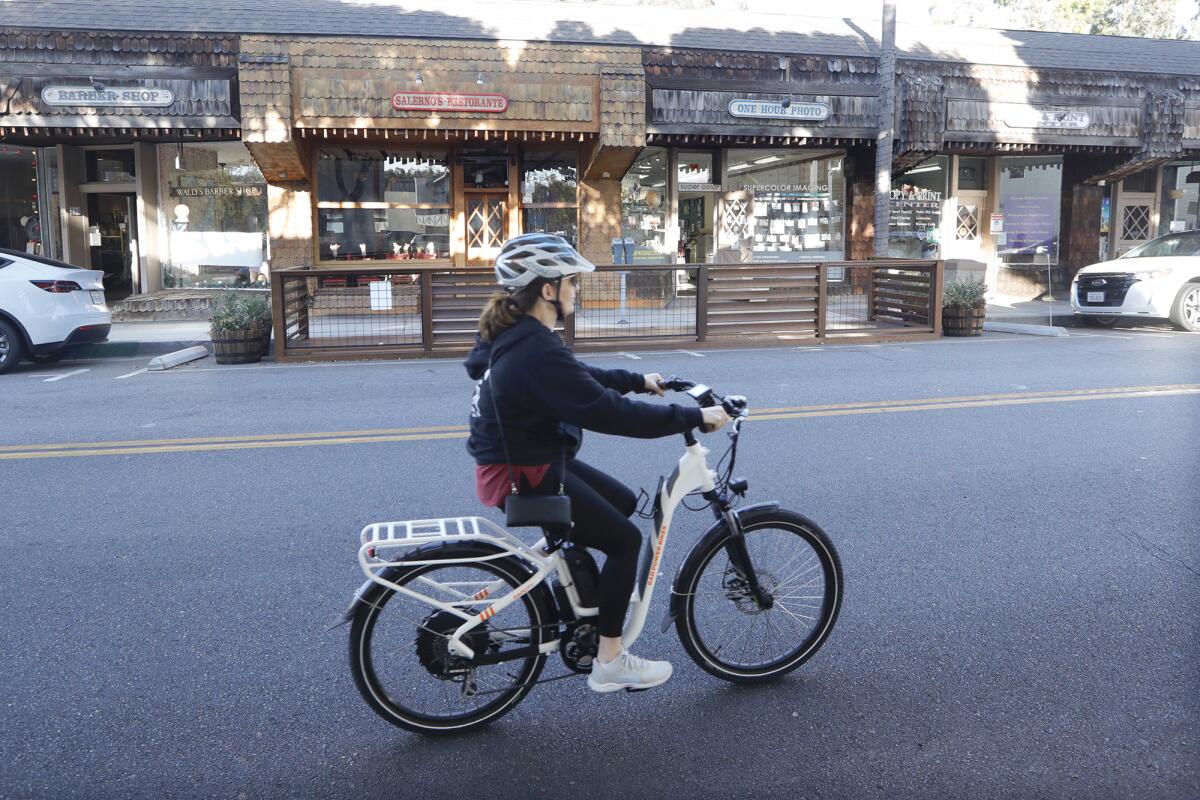Apodaca: Will the e-bike revolution run out of juice?

- Share via
Remember Segways?
Perhaps you once rode one while on vacation or spotted a police officer on one or recall them as a favorite mode of transport for a character on “Arrested Development,” the TV comedy about a fictional Newport Beach family.
But have you seen one lately? Probably not. Production of the two-wheeled vehicles ended nearly three years ago, a sad closing to Segway’s weird history.
There had been a frenzy of breathless predictions about its significance before the device was even unveiled to the public in late 2001. Steve Jobs compared its potential impact to that of the PC.
But that hyped debut was followed by dismal sales, revolving-door ownership and widespread ridicule for giving its riders goofy, “Paul Blart: Mall Cop” energy. President George W. Bush famously took a tumble off of one, and one of the company’s owners — I’m not making this up — died when he accidentally rode his Segway off a cliff.
For all its problems, perhaps the most significant factor in the Segway’s demise was the lack of infrastructure needed to make its use practical on the scale envisioned by its idealistic designer. Our roads, highways, trails and system of traffic control weren’t built for such a vehicle, and the dangers and difficulties of riding one on city streets and rural byways was glaringly evident from the get-go.
Yet some of those familiar with Segway still consider its design revolutionary and believe that all the battery-powered, single-user vehicles that followed are its direct descendants.
Which brings us to e-bikes.
Electric-powered bicycles are having a moment. Although e-bikes have been around in some form or another since the 1890s, it wasn’t until the 1990s that they started to be marketed on a broader scale as a relatively inexpensive, environmentally friendly, traffic-reducing way to get around town, and their popularity steadily grew.
But when the pandemic hit in 2020, e-bike sales exploded as home-bound consumers looked for new ways to enjoy the outdoors and make short trips. Sales are expected to stay strong. Data Bridge Market Research estimates that the global e-bike market, valued at $47 billion in 2021, will reach $102.97 billion by 2029.
Daily Pilot columnist Patrice Apodaca explores the drop in college enrollment, especially in pursuit of liberal arts degrees.
Despite the impressive growth and undeniable appeal of e-bikes, many questions and concerns have yet to be addressed. Chief among them are worries about their safety, particularly when kids are involved. Like the Segway before them, today’s e-bikes don’t always fit comfortably in the world we’ve built.
There are three basic types of e-bikes: Class 1, pedal-assist only with a maximum assisted speed of 20 miles per hour; Class 2 has an added throttle-powered mode and also a top assisted speed of 20 miles per hour; and pedal-assist-only Class 3, with a top assisted speed of 28 miles per hour.
The laws and regulations that govern e-bikes are essentially the same as conventional bikes. No training or licensing is required, and kids can ride Class 1 and 2 e-bikes as long as they wear helmets and follow the rules of the road, such as stopping at red lights and stop signs. Ages 16 and older are allowed on all three classes of e-bikes, but are only required to wear helmets on Class 3.
The worries over the potential for accidents are grounded in recent experience. The emergency room at the Children’s Hospital of Orange County has treated 85 e-bike injuries in the past three years, including 34 in the last six months. Anyone who’s seen a 12-year-old whiz by on an e-bike can see why.
Lawmakers have been scrambling to keep up, as they seek to balance the need to reduce carbon emissions and promote alternative modes of transport with safety concerns. A new state law prevents cities from restricting access to e-bike riders in places like bicycle paths or trails, bikeways and bicycle lanes, while state Sen. Dave Min (D-Irvine) recently introduced a bill that would authorize a study on best practices for improving e-bike safety.
“This is a case where technology is outpacing policy,” observed Lt. Eric Little of the Newport Beach Police Department.
In any given year, Newport Beach typically experiences 100 to 200 crashes involving bicycles. While that hasn’t changed, the proportion involving e-bikes has risen in the past three years from 10%, to upwards of 50%.
“We are aware of the concerns of the community and we are taking steps to address them,” Little said.
Traffic officers have been targeting areas where e-bike traffic tends to be high, but he stressed that it will take far more than just writing tickets to ease concerns. The NBPD has also focused considerable resources on education and community outreach, giving presentations on the responsible use of e-bikes at schools, PTA meetings and other places.
“I think that maybe, in a broad sense, many parents that buy their kids e-bikes aren’t aware of the capabilities of these e-bikes,” he noted.
It’s a heavy lift to expect e-bikes to completely transform transportation in the manner once predicted for the late, lamented Segway. Despite their surging popularity, they could end up as just another one of history’s cautionary tales.
A more likely outcome falls somewhere in between — they will be one piece of a transportation patchwork that includes many types of zero-emission vehicles. But for that scenario to be successful, we’ll need to find ways to safely and effectively accommodate these newer devices in our busy, built-up world.
All the latest on Orange County from Orange County.
Get our free TimesOC newsletter.
You may occasionally receive promotional content from the Daily Pilot.





